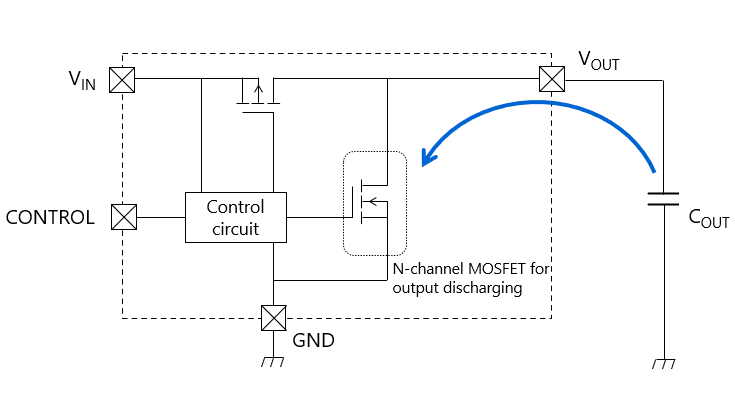2-3. Thermal shutdown (TSD) operation of LDO regulators

In the event of excessive power dissipation or the junction temperature exceeding a threshold due to an excessive increase in ambient temperature, the thermal shutdown (TSD) function turns off an LDO regulator to protect itself and the system in which it is used.
LDO regulators have a thermal shutdown temperature and a recovery temperature. The thermal shutdown temperature is the temperature at which TSD is tripped in the event of an increase in junction temperature in order to turn off an LDO regulator. Once the LDO regulator is turned off, it dissipates no power; so the junction temperature begins to fall. When the junction temperature reaches the recovery temperature, the LDO regulator turns back on automatically and supplies the regulated voltage to the subsequent IC and circuitry. The recovery temperature is the temperature at which the LDO regulator turns back on after TSD forces it off. In the datasheets of LDO regulators, a difference between the shutdown and recovery temperatures is specified as thermal shutdown hysteresis.
Once thermal shutdown is tripped, its cause must be removed to set the CONTROL pin Low. If the CONTROL pin is left High, the junction temperature increases again. This causes an LDO regulator to enter the following loop: a turn-off of an LDO regulator → a decrease in junction temperature → a turn-on of the LDO regulator → an increase in junction temperature. The LDO regulator should not be left at an excessive temperature for an extended period because doing so might affect the system stability or degrade the reliability of the LDO regulator. Be sure to provide a fail-safe mechanism for a system in case of thermal shutdown.
The following links also provide a description of thermal shutdown:
Application note: Basics of Low-Dropout (LDO) Regulator ICs
FAQ: What is the thermal shutdown (TSD) that is available with LDO regulators?
You can perform a parametric search of LDO regulators with a thermal shutdown function:
Parametric search of LDO regulators with a thermal shutdown feature
Chapter2 Convenient functions of LDO
Related information
- Products
Low-Dropout Regulators (LDO Regulators) - Applidcation Notes
Application Notes - FAQs
LDO Regulators - Parametric Search
LDO Regulators - Stock Check & Purchase
Stock Check & Purchase






